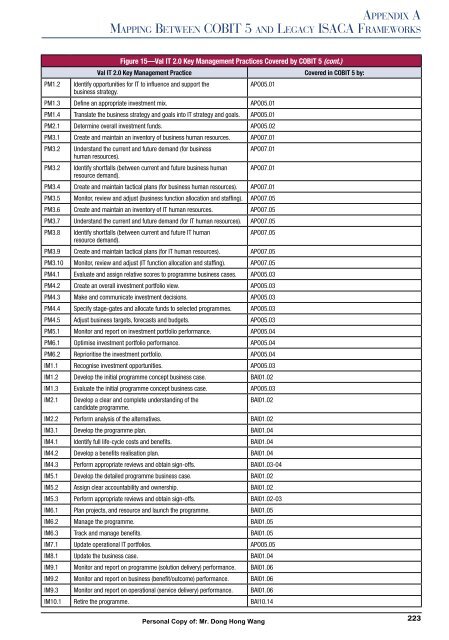Enabling Processes
Enabling Processes
Enabling Processes
You also want an ePaper? Increase the reach of your titles
YUMPU automatically turns print PDFs into web optimized ePapers that Google loves.
APPENDIX A<br />
MAPPING BETWEEN COBIT 5 AND LEGACY ISACA FRAMEWORKS<br />
Figure 15—Val IT 2.0 Key Management Practices Covered by COBIT 5 (cont.)<br />
Val IT 2.0 Key Management Practice Covered in COBIT 5 by:<br />
PM1.2 Identify opportunities for IT to influence and support the<br />
business strategy.<br />
APO05.01<br />
PM1.3 Define an appropriate investment mix. APO05.01<br />
PM1.4 Translate the business strategy and goals into IT strategy and goals. APO05.01<br />
PM2.1 Determine overall investment funds. APO05.02<br />
PM3.1 Create and maintain an inventory of business human resources. APO07.01<br />
PM3.2 Understand the current and future demand (for business<br />
human resources).<br />
APO07.01<br />
PM3.2 Identify shortfalls (between current and future business human<br />
resource demand).<br />
APO07.01<br />
PM3.4 Create and maintain tactical plans (for business human resources). APO07.01<br />
PM3.5 �������� ������ ��� ������ ��������� �������� ���������� ��� ���������� APO07.05<br />
PM3.6 Create and maintain an inventory of IT human resources. APO07.05<br />
PM3.7 Understand the current and future demand (for IT human resources). APO07.05<br />
PM3.8 Identify shortfalls (between current and future IT human<br />
resource demand).<br />
APO07.05<br />
PM3.9 Create and maintain tactical plans (for IT human resources). APO07.05<br />
PM3.10 �������� ������ ��� ������ ��� �������� ���������� ��� ���������� APO07.05<br />
PM4.1 Evaluate and assign relative scores to programme business cases. APO05.03<br />
PM4.2 Create an overall investment portfolio view. APO05.03<br />
PM4.3 Make and communicate investment decisions. APO05.03<br />
PM4.4 Specify stage-gates and allocate funds to selected programmes. APO05.03<br />
PM4.5 ������ �������� �������� ��������� ��� �������� APO05.03<br />
PM5.1 Monitor and report on investment portfolio performance. APO05.04<br />
PM6.1 Optimise investment portfolio performance. APO05.04<br />
PM6.2 Reprioritise the investment portfolio. APO05.04<br />
IM1.1 Recognise investment opportunities. APO05.03<br />
IM1.2 Develop the initial programme concept business case. BAI01.02<br />
IM1.3 Evaluate the initial programme concept business case. APO05.03<br />
IM2.1 Develop a clear and complete understanding of the<br />
candidate programme.<br />
BAI01.02<br />
IM2.2 Perform analysis of the alternatives. BAI01.02<br />
IM3.1 Develop the programme plan. BAI01.04<br />
IM4.1 Identify full life-cycle costs and benefits. BAI01.04<br />
IM4.2 Develop a benefits realisation plan. BAI01.04<br />
IM4.3 Perform appropriate reviews and obtain sign-offs. BAI01.03-04<br />
IM5.1 Develop the detailed programme business case. BAI01.02<br />
IM5.2 Assign clear accountability and ownership. BAI01.02<br />
IM5.3 Perform appropriate reviews and obtain sign-offs. BAI01.02-03<br />
IM6.1 ���� ��������� ��� �������� ��� ������ ��� ���������� BAI01.05<br />
IM6.2 Manage the programme. BAI01.05<br />
IM6.3 Track and manage benefits. BAI01.05<br />
IM7.1 Update operational IT portfolios. APO05.05<br />
IM8.1 Update the business case. BAI01.04<br />
IM9.1 Monitor and report on programme (solution delivery) performance. BAI01.06<br />
IM9.2 ������� ��� ������ �� �������� ����������������� ������������ BAI01.06<br />
IM9.3 Monitor and report on operational (service delivery) performance. BAI01.06<br />
IM10.1 Retire the programme. BAI10.14<br />
Personal Copy of: Mr. Dong Hong Wang<br />
223


